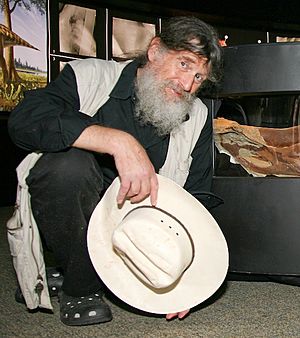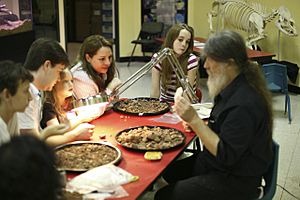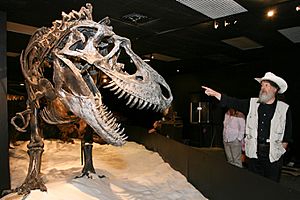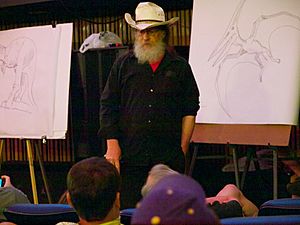Robert T. Bakker facts for kids
Quick facts for kids
Robert T. Bakker
|
|
|---|---|

Bakker in 2008
|
|
| Born | March 24, 1945 Bergen County, New Jersey, United States
|
| Alma mater | Yale University (B.A., 1968) Harvard University (Ph.D, 1971) |
| Known for | The "dinosaur renaissance" |
| Scientific career | |
| Fields | Paleontology |
| Institutions | Johns Hopkins University Houston Museum of Natural Science |
| Doctoral advisor | John Ostrom |
| Doctoral students | Blaire Van Valkenburgh |
Robert Thomas Bakker (born March 24, 1945) is an American paleontologist. He helped change how we think about dinosaurs. He strongly supported the idea that some dinosaurs were endothermic, meaning warm-blooded.
Along with his teacher John Ostrom, Bakker started the "dinosaur renaissance." This was a new way of studying dinosaurs. It began with his article "Dinosaur Renaissance" in Scientific American in 1975. He specializes in how dinosaurs lived in their ecological settings and how they behaved.
Bakker believes dinosaurs were warm-blooded, smart, fast, and could adapt well. He published his first paper on this idea in 1968. His important book, The Dinosaur Heresies, came out in 1986. He found the first proof of parent dinosaurs caring for their young at Allosaurus nesting sites. He also saw evidence for punctuated equilibrium in dinosaur groups. This idea suggests that evolution happens in quick bursts. Today, Bakker is the Curator of Paleontology at the Houston Museum of Natural Science.
Contents
About Robert Bakker

Robert Bakker was born in Bergen County, New Jersey. He became interested in dinosaurs after reading an article in Life magazine in 1953. He finished Ridgewood High School in 1963.
At Yale University, Bakker studied with John Ostrom. Ostrom was one of the first to support new ideas about dinosaurs. Bakker later earned his PhD from Harvard University. He started teaching anatomy at Johns Hopkins University in Baltimore, Maryland. He also taught Earth and Space Sciences there.
Most of Bakker's work in the field has been in Wyoming, especially at Como Bluff. He has also traveled to places like Mongolia and South Africa. He went there to find dinosaur habitats. He also worked as an assistant at the University of Colorado.
Bakker's Dinosaur Theories

In his 1986 book, The Dinosaur Heresies, Bakker presented his theory. He suggested that dinosaurs were warm-blooded. Here is some of the evidence he used:
- Most modern animals that walk upright are warm-blooded. Dinosaurs also walked upright.
- Warm-blooded animals have very effective hearts. A giant Brachiosaurus would need such a heart to pump blood to its head.
- Dinosaurs like Deinonychus were very active. This behavior fits better with a warm-blooded animal.
- Some dinosaurs lived in cold northern areas. It would have been hard for cold-blooded dinosaurs to stay warm there.
- Dinosaurs changed and evolved quickly. This is typical for warm-blooded animals, not cold-blooded ones.
- The number of meat-eating dinosaurs compared to their prey suggests they were warm-blooded. This ratio is like that of modern warm-blooded predators.
- Birds are warm-blooded and came from dinosaurs. So, dinosaurs must have become warm-blooded at some point.
- Being warm-blooded helps top predators and large plant-eaters. If dinosaurs were not warm-blooded, other warm-blooded animals should have taken their place. But this did not happen.
- Dinosaurs grew fast. We can see this by looking at cross-sections of their bones. Warm-blooded animals also grow quickly.
Bakker also believes that flowering plants evolved because of how they interacted with dinosaurs. He thinks that a sickness caused by new species crossing land bridges led to the extinction of non-bird dinosaurs. He argues that if a comet was big enough to kill all non-bird dinosaurs, it would have also wiped out other animals that survived.
Fiction Writing
Bakker wrote a fictional novel called Raptor Red. It tells the story of a year in the life of a female Utahraptor. This was during the early Cretaceous period. In the book, Bakker shares his knowledge about how dromaeosaurids (often called "raptor" dinosaurs) behaved. He also describes what life was like during their time.
Religious Views
Robert Bakker is a Pentecostal, Ecumenical Christian minister. He has stated that there is no real conflict between religion and science. He believes that the evolution of species and Earth's history fit with religious belief. Bakker sees the Bible as a guide for ethics and morals. He does not view it as a literal timeline of events in life's history. He has suggested that people read the ideas of Saint Augustine. Augustine also argued against a literal understanding of the Book of Genesis.
Influence in Popular Culture
Bakker first appeared in the 1976 BBC Nova episode The Hot-Blooded Dinosaurs. He also took part in the 1985 CBS documentary Dinosaur!. He appeared many times in that program.
Bakker was featured in the 1989 BBC series Lost Worlds, Vanished Lives. This series was presented by David Attenborough. In the third episode, "Dinosaur," Bakker discussed his theory. He talked about Tyrannosaurus rex and other large meat-eating dinosaurs being warm-blooded. Bakker later named a species of plesiosaur, Attenborosaurus, after Sir David.
Bakker was also a big part of the documentary The Great Dinosaur Hunt. This was part of The Infinite Voyage series. The Great Dinosaur Hunt first aired on January 4, 1989.
Bakker was an advisor for the 1992 PBS series, The Dinosaurs!. He appeared many times in the TLC television series Paleoworld. He was also an advisor for the movie Jurassic Park. Some of the early drawings for the movie were based on Bakker's work. Bakker also appeared in the Sega CD version of Jurassic Park.
Dr. Bakker was a guest on episode 27 ("Surprise") of the Williams Street show Space Ghost Coast to Coast. He also appeared in the 1992 VHS video Whatever Happened to the Dinosaurs?.
In 1992, he was featured in an episode of Discover Magazine (TV series) on The Disney Channel. This segment showed him at his dinosaur dig site in Wyoming.
Bakker and his 1986 book are mentioned in the original Jurassic Park novel. In the movie The Lost World: Jurassic Park, there is a character named Dr. Robert Burke. He is a paleontologist with a beard. This character is a friendly caricature of Bakker. In real life, Bakker believed T. rex was a hunter. His fellow paleontologist Jack Horner thought it was mainly a scavenger. Horner said that director Steven Spielberg created the character of Burke and had him eaten by the T. rex as a favor to Horner. After the movie came out, Bakker recognized himself in Burke. He liked the caricature and even sent Horner a message saying, "See, I told you T. rex was a hunter!" In 1993, Bakker starred in a TV commercial for the Sega Genesis Jurassic Park game.
See also
 In Spanish: Robert Bakker para niños
In Spanish: Robert Bakker para niños
- Dinosaur renaissance
- Physiology of dinosaurs


